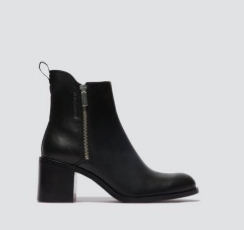I have always believed that a designer’s workbench tells a story before the final product ever does. When I first had the chance to visit the Fly London studio, the first thing that struck me wasn’t the finished shoes on display, but the small, almost chaotic desk covered with sketches, leather swatches, and pieces of hardware that seemed to wait for their moment. There was an energy in that space, not loud or boastful, but steady and patient—the kind of energy you only feel when something is made with intent.
The studio was filled with little fragments of ideas, some of them already recognizable as early prototypes of shoes, others just scraps of colored paper pinned on the wall. What fascinated me most was a corner of the desk with two unfinished pairs, each marked by pencil lines and hand-sewn threads. They weren’t meant to be seen by the public, at least not yet, but in those imperfect forms you could read the patience of the process. It was a reminder that what eventually becomes a style on someone’s feet often begins as trial and error, as quiet experimentation.
Watching the designers at work, I noticed how much attention was given to materials. The leather wasn’t just soft or durable—it carried personality. Some pieces had a grain that felt almost raw, while others had a subtle sheen that caught the light without being flashy. The way they handled it was almost reverent, as though they were trying to let the material speak before deciding what shape it should become. That reverence is something you can feel in every pair of their boots and sandals.
One designer explained to me that they like to work with contrasts—thick soles with unexpectedly refined stitching, bold buckles paired with understated colors. It is in those juxtapositions that the brand’s identity lives. On the desk, I saw sketches where exaggerated lines of a platform heel were drawn beside a delicate strap, testing how far the balance could be pushed without losing wearability. It felt like looking at the diary of someone who communicates best through shapes and textures.
What touched me most was the way unfinished pieces were treated not as mistakes but as milestones. There was one boot, half constructed, with visible seams and a sole that had yet to be attached. To anyone else, it might have looked like clutter, but to the designer it was a memory of the thought process—proof that each product is less about mass production and more about evolution.
I couldn’t help but think about how these details translate into the everyday experience of wearing their shoes. For me, slipping into a pair feels less like buying an item and more like inheriting a story. It’s the comfort of knowing that the soft lining was tested against hours of wear, that the bold silhouettes were debated and refined at that very workbench. You walk with a part of their patience, their insistence on making every detail matter.
When I later came across fly london ireland online, I was reminded of those unfinished prototypes I had seen. The polished designs on the screen carried the same DNA as the half-stitched versions on the desk. They felt familiar because I had witnessed the quiet work that led them here. And that is what makes exploring a brand’s behind-the-scenes so moving—the realization that beauty is never just accidental, but the result of unseen hours, imperfect trials, and deeply human choices.
